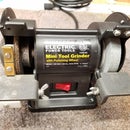Introduction: Remote Snow Sensor
Operation Overview
The snow depth sensor transmitter a) emits infrared light. The light is reflected back to the transmitter that receives the infrared light in a position sensitive detector. As snow accumulates on the sensing platform b), the angle of reflected light changes. This change is detected by the position sensitive detector and converted to a digital quantity. This quantity is encoded and transmitted via the antenna c) to the indoor receiver.
The transmitter signal is received by the indoor receiver antenna e). The transmitted signal is decoded by the receiver and displayed as a snow depth reading in inches and tenths of an inch f). When the snow depth reaches a user level set using the alarm set buttons g) (not visible), the built-in alarm sounds. The alarm is de-activated by the toggle switch on top of the receiver.
Step 1: Receiver Construction
This is a typical receiver prototype, with the exception of an additional ribbon cable that was used for serially logging the raw snow depth data and transmitter internal temperature control.
Attachments
Step 2: Transmitter Construction
The transmitter housing is designed to as much as possible thermally decouple the Sharp GP2DO2 range sensor and electronics from outside temperature swings. The cover of the outer case is sealed with RTV to prevent water incursion.
Attachments
Step 3: Calibration Example
Each GP2DO2 range sensor has slightly different output characteristics. Added to this problem is that the output is also non-linear. To make the sensor useful for this project, the raw sensor output has to measured throughout its useful range, about 550mm to 110mm, and linearized. The goal is to select a continuous range of output from the sensor that can be used to represent snowfall levels from 0 to about 6 inches. The selection process is biased to provide the greatest accuracy in the range of 1 to 3 inches.
Attachments
Step 4: Transmitter Stand Mounting
The transmitter is mounted to the pvc transmitter stand using clamps. This allows upward or downward movement of the transmitter housing during the calibration procedure.














